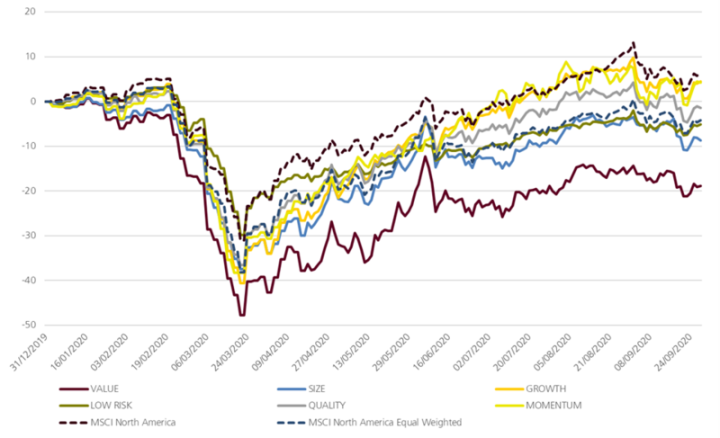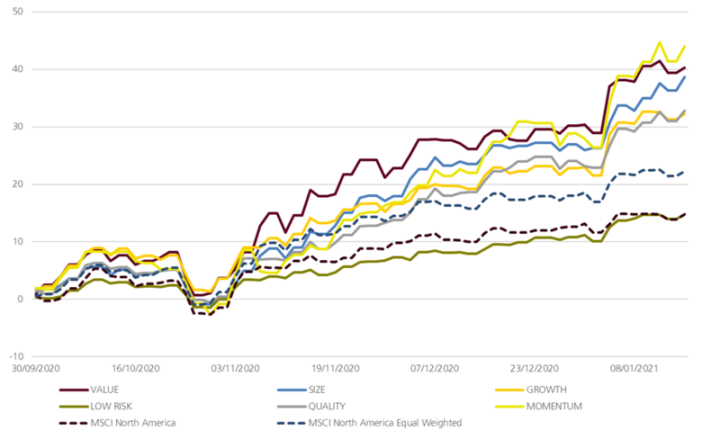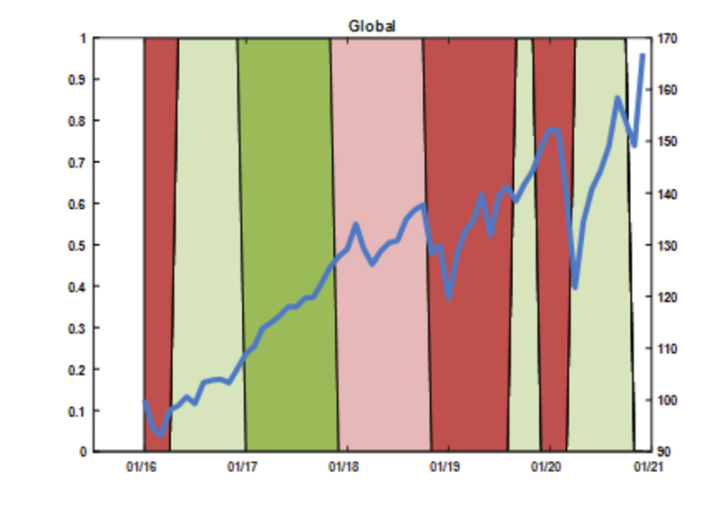Low Risk is not No Risk

Dr. Martin Schlatter, CEFA
Financial Markets
The announcement in early November that the first vaccines have been successfully tested and approved by health authorities, combined with other large stimulus packages, has triggered a fierce sector and style rotation in the markets. This rotation is a clear sign that markets expect a clear pick-up in economic growth after Q2 2021.
The announcement in early November that the first vaccines have been successfully tested and approved by health authorities, combined with other large stimulus packages, has triggered a fierce sector and style rotation in the markets. This rotation is a clear sign that markets expect a clear pick-up in economic growth after Q2 2021.
How has this rotation affected the different investment styles? The charts below show on a daily basis the return performance of different styles calculated by Swiss Rock. In each case, the top 5% of stocks from the North American equity universe are selected and equally weighted to form a portfolio.
The first chart covers the period from the end of 2019 to the end of September 2020. Clearly visible is the dominance of large-cap stocks, as the cap-weighted MSCI North America Index (dashed brown) significantly outperformed the equally-weighted index (dashed blue).
The investment styles growth ("Growth") and momentum have performed well, while the clear loser substance ("Value") is also quickly found. In the midfield is the "Low-Risk" strategy, which focuses on stocks with low risks. During the crisis until mid-March, this was the best strategy.
Since the beginning of the last quarter, the situation has completely turned around. Yesterday's losers are today's winners and vice versa. The first striking thing is that the equally weighted North America Index has beaten the capitalization weighted one. This is because the very good returns of the smaller companies have a much stronger impact on the index returns when they are equally weighted. Value has also become the star, along with Momentum.
Low Risk, on the other hand, remains well down in last place among the style strategies.
Why do such violent rotations occur and are they really related to the expected economic development?
We analyze the return on styles with a simple model that maps the economic cycle with four phases. The model is based on the OECD's leading indicators. For global equity markets, the model indicates an expected economic recovery since Q2 2020, after we had previously indicated a contraction. The colors light green indicate a recovery, dark green expansion, light red weakening and dark red negative growth.
How do the different styles behave in the different phases of the economy? To do this, we have regressed the different styles on the business cycle (over the last 20 years) and give the monthly relative returns of the styles for the different phases of the cycle in each case.
Red indicates clear underperformance and green indicates outperformance. According to this model, we expect good returns from "Growth" and "Low Risk" in a downturn, while "Value" returns worse. The tendency for Value to underperform in a downturn has become more pronounced in recent years.
When the economy recovers, low-risk stocks in particular begin a period of underperformance, while value stocks perform very positively. This is exactly the behavior we observed in Q3/Q4 last year.
The table impressively shows that there is no single correct investment style. To avoid prolonged periods of underperformance in the portfolio, all investment styles should be represented. Even the "Value Style", which has been very poorly yielding and scorned for a long time, has now made an impressive comeback. Therefore, a balanced style allocation is a prerequisite for stable portfolio returns.
What could happen next? According to the cycle model, a recovery phase is followed by expansion. This leads to the recommendation to remain invested in momentum, growth and value and to underweight low risk stocks. Is it too late for investors who were previously invested exclusively or heavily in "low risk"? We believe no; we have not even reached the expansion phase yet. The underperformance of low-risk stocks may therefore continue for some time yet.





